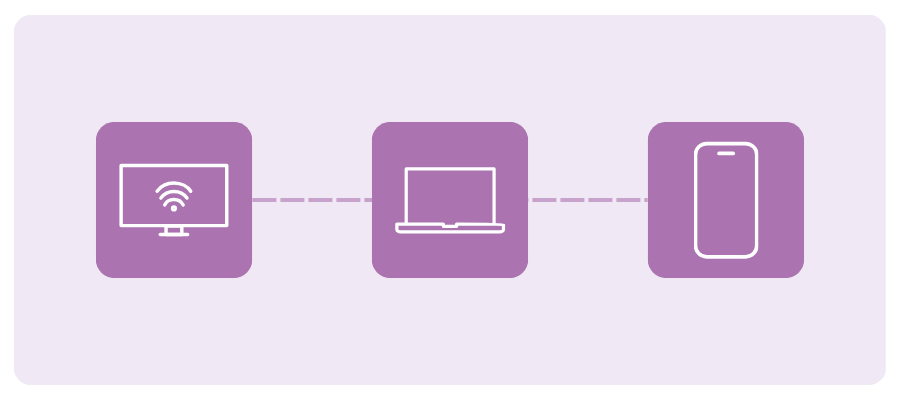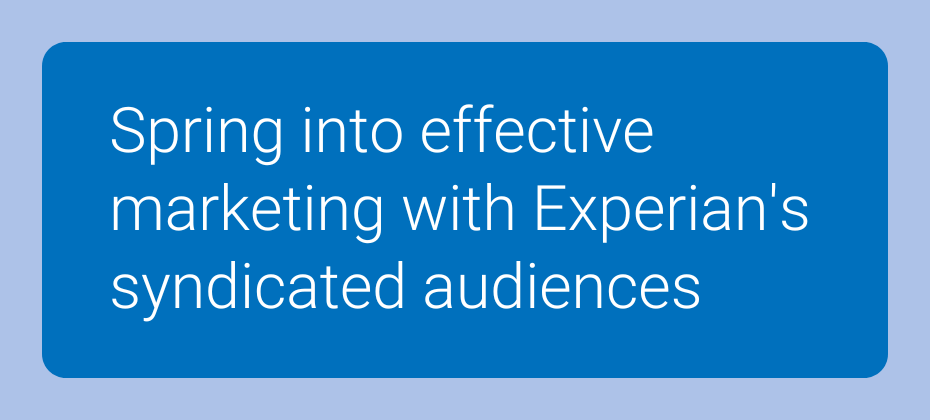At A Glance
Infillion and Experian collaborate to help advertisers connect with audiences across devices and channels, as cookies and mobile identifiers disappear. By integrating Experian's Digital Graph and Offline Identity Resolution, Infillion strengthens identity connections, improves campaign reach, and enhances audience engagement across CTV, mobile, and web.In our Ask the Expert Series, we interview leaders from our partner organizations who are helping lead their brands to new heights in AdTech. Today’s interview is with Ben Smith, VP of Product, Data Products at Infillion.
Adapting to signal loss
What does the Experian–Infillion integration mean for advertisers looking to reach audiences as signals fade?

As cookies and mobile identifiers disappear, brands need a new way to find and reach their audiences. The Experian integration strengthens Infillion’s XGraph, a cookieless, interoperable identity graph that supports all major ID frameworks, unifying people and households across devices with privacy compliance, by providing a stronger identity foundation with household- and person-level data. This allows us to connect the dots deterministically and compliantly across devices and channels, including connected TV (CTV). The result is better match rates on your first-party data, more scalable reach in cookieless environments, and more effective frequency management across every screen.
Connecting audiences across channels
How does Experian’s Digital Graph strengthen Infillion’s ability to deliver addressable media across channels like CTV and mobile?

Experian strengthens the household spine of XGraph, which means we can accurately connect CTV impressions to the people and devices in that home – then extend those connections to mobile and web. This lets us plan, activate, and measure campaigns at the right level: household for CTV, and person or device for mobile and web. The outcome is smarter reach, less waste from over-frequency, and campaigns that truly work together across channels.
The value of earned attention
Infillion has long championed “guaranteed attention” in advertising. How does that philosophy translate into measurable outcomes for brands?

Our engagement formats, such as TrueX, are based on a simple principle: attention should be earned, not forced. Viewers choose to engage with the ad and complete an action, which means every impression represents real, voluntary attention rather than passive exposure. Because of that, we consistently see stronger completion rates, deeper engagement, and clearer downstream results – like lower acquisition costs, improved on-site behavior, and measurable brand lift.
To take that a step further, we measure attention through UpLift, our real-time brand lift tool. UpLift helps quantify how exposure to a campaign influences awareness, consideration, or purchase intent, providing a more complete picture of how earned attention translates into business impact.
Creative innovation and location insights
Beyond identity resolution, what are some of Infillion’s capabilities, like advanced creative formats or location-based insights, that set you apart in the market?

One key area is location intelligence, which combines privacy-safe geospatial insights with location-based targeting through our proprietary geofencing technology. This allows us to build custom, data-driven campaigns that connect media exposure to real-world outcomes – like store visits and dwell time – measured through Arrival, our in-house footfall attribution product.
We also build custom audiences using a mix of zero-party survey data, first-party location-based segments, and bespoke audience builds aligned to each advertiser’s specific strategy.
Then there’s creative innovation, which is a major differentiator for us. Our high-impact formats go beyond static display, such as interactive video units that let viewers explore products through hotspots or carousels, rich-media ads that feature polls, quizzes, dynamic distance, or gamified elements, and immersive experiences that encourage active participation rather than passive viewing. These creative formats not only capture attention but also generate deeper engagement and stronger performance for a variety of KPIs.
Future ready media strategies
How does Infillion’s ID-agnostic approach help brands future-proof their media strategies amid ongoing privacy and tech changes?

We don’t put all our eggs in one basket. XGraph securely unifies multiple durable identifiers alongside our proprietary TrueX supply to strengthen CTV household reach. This agnostic design allows us to adapt as platforms, regulations, and browsers evolve – so you can preserve reach and measurement capabilities without getting locked into a single ID or losing coverage when the next signal deprecates.
Raising the bar for media accountability
Looking ahead, how is Infillion evolving its platform to meet the next wave of challenges in audience engagement and media accountability?
From an engagement standpoint, we’re expanding our ability to support the full customer journey, offering ad experiences that move seamlessly from awareness to consideration to conversion. That includes smarter creative that adapts to context, intelligent targeting and retargeting informed by real data, and formats designed to drive measurable outcomes rather than just impressions.
When it comes to accountability, we’re ensuring that measurement is both flexible and credible. In addition to our proprietary tools, we partner with leading third-party measurement providers to validate results and give advertisers confidence that their investment is truly performing. Within our DSP, we emphasize full transparency and log-level data access, ensuring advertisers can see exactly what’s happening on every impression.
All of this builds toward the next era of agentic media buying – one enabled by our MCP suite and modular, component-based tools. This evolution brings greater accountability and next-generation audience engagement to an increasingly automated, intelligent media landscape. Our goal is to help brands connect more meaningfully with audiences while holding every impression – and every outcome – to a higher standard of transparency and effectiveness.
Driving impact across the funnel
What is a success story or use cases that demonstrate the impact of the Experian–Infillion integration?
We recently partnered with a national veterans’ organization to raise awareness of its programs for injured or ill veterans and their families. Using the Experian integration, we combined persistent household- and person-level identifiers with cross-device activation to reach veteran and donor audiences more precisely across CTV, display, and rich media. The campaign achieved standout results – industry-leading engagement rates, a 99% video completion rate, and measurable lifts in both brand awareness (3.6 % increase) and donation consideration (13.7% lift). It’s a clear example of how stronger identity and smarter activation can drive meaningful outcomes across the full funnel.

Contact us
FAQs
Identity resolution ensures accurate connections between devices, households, and individuals. Experian’s Offline Identity Resolution and Digital Graph strengthen these connections for improved targeting and consistent measurement across CTV, mobile, and web.
Solutions like Experian’s Digital Graph enable brands to connect first-party data to household and person-level identifiers, ensuring scalable reach and compliant audience targeting legacy signals fade.
Focusing on earned attention (where audiences actively choose to engage) leads to stronger completion rates, improves on-site behavior, and drives measurable increases in brand awareness and consideration.
By linking CTV impressions to households and extending those connections to mobile and web, Experian’s identity solutions ensure campaigns work together seamlessly, reducing over-frequency and improving overall reach.
About our expert

Ben Smith, VP Product, Data Products
Ben Smith leads Infillion’s Data Products organization, delivering identity, audience, and measurement solutions across the platform. Previously, he was CEO and co-founder of Fysical, a location intelligence startup acquired by Infillion in 2019.
About Infillion

Infillion is the first fully composable advertising platform, built to solve the challenges of complexity, fragmentation, and opacity in the digital media ecosystem. With MediaMath at its core, Infillion’s modular approach enables advertisers to seamlessly integrate or independently deploy key components—including demand, data, creative, and supply. This flexibility allows brands, agencies, commerce and retail media networks, and resellers to create tailored, high-performance solutions without the constraints of traditional, all-or-nothing legacy systems.
Latest posts

Third-party cookies have been the foundation of targeted advertising for a long time. Around 75% of marketers worldwide rely on third-party cookies, with approximately 42.2% of websites using them to gather user data. These tiny bits of code silently track our online activities, collecting search history and product preferences to help advertisers tailor their campaigns to our needs. However, as fears over online privacy have grown, the third-party cookie era is ending. Most American consumers are worried about data privacy when engaging with brands online. Privacy concerns are widespread across all age groups, with 82.7% of 18- to 24-year-olds and 87.8% of 55- to 65-year-olds expressing apprehension about how their data is handled, according to eMarketer. While some other search engines have already eliminated third-party cookies, Google Chrome — which holds 65% of the global browser market — is just beginning to phase them out as new alternatives are tested. Google’s third-party cookie deprecation is expected to impact marketers in a big way. Let’s talk about what that impact will look like and how marketers can reconcile consumer demands for browsing privacy with their preference for personalized ad experiences. What is cookie deprecation? Cookie deprecation is a process where web browsers, like Google Chrome, phase out the use of a specific cookie type. In the context of this article, we’re referring to third-party cookies, small pieces of data stored on a device by websites a person visits. Advertisers and other companies use third-party cookies to track a person’s actions on the web. They help those companies learn about an individual’s interests and show them targeted ads. But over time, internet users have become more aware of cookies and how much companies know about them, so browsers are phasing out third-party cookies to respect user privacy. The timeline and reasons behind the shift In January 2020, Google announced it would no longer allow third-party marketing cookies by 2022. Realizing it needed to find an alternative first, it pushed the deadline back several times over the years, eventually confirming that third-party cookies would be deprecated by the end of 2024 — a big deal for the advertising industry. So, what’s the motivation behind this change? Many people are becoming increasingly worried about online privacy and the intrusiveness of third-party cookies. In recent years, lawmakers have pressured tech companies to make changes in response to their constituents’ concerns about online privacy rights. By getting rid of third-party cookies, browsers like Chrome are trying to give users more control over their data and respect privacy demands to create a more privacy-friendly browsing experience. This shift is part of a broader trend in the digital world toward greater privacy protections, with browsers like Firefox and Safari having already phased out third-party cookies. We've also seen other significant moves in this direction, including the following. These regulatory efforts reflect a growing awareness of how important it is to protect data privacy and consumer rights in a world gone digital. Apple's App Tracking Transparency (ATT) framework was introduced in iOS 14.5, requiring users to get permission before tracking their data across other apps or websites. The Global Privacy Control (GPC) strives to improve users’ control over their internet privacy by letting them signal their preferences for data sharing. Europe’s General Data Protection Regulation (GDPR) and California’s Consumer Privacy Act (CCPA) have strict guidelines for how companies handle personal data to prioritize transparency and user consent. Google's most popular browser, Chrome, recently made its first big move toward third-party cookie deprecation. On January 4, 2024, Google announced the rollout of a new "Tracking Protection" feature, limiting cross-site tracking by default. They're doing this gradually, activating the feature for 1% of random Chrome users worldwide, about 30 million people. Google Chrome’s cookie phase-out impact Chrome’s third-party cookie deprecation is expected to have the farthest-reaching consequences for marketers like you, as it has almost two-thirds of the browser market worldwide. It's important to note that this phase-out specifically targets third-party cookies, not first-party cookies, which are generated and stored by the website a user visits directly and will be unaffected by this change. Here are a few of the impacts to prepare for. Reduced tracking capabilities Once third-party cookies are eliminated, you may face challenges in understanding consumer behavior across different websites. Without this tracking capability, understanding your audiences and effectively tailoring advertising campaigns might become more difficult. Required shift in strategy It will be key for you to adapt your advertising strategies to rely less on third-party data and more on alternative targeting methods. This shift may involve greater emphasis on contextual advertising, which targets people based on the content of the websites they visit instead of browsing history, and first-party data gathered directly from site users to personalize advertising campaigns. Additionally, in order to move beyond reliance on cookies and third-party identifiers, activation platforms like demand-side platforms (DSPs) must evolve to identify addressable IDs within bid streams. This adaptability is essential as digital advertising shifts toward privacy and cookieless environments. By being able to recognize addressable IDs in bid streams, DSPs can help facilitate more accurate, personalized targeting and help advertisers reach their audiences across channels and devices without privacy concerns. As a marketer, you should understand the capabilities of your chosen platforms and inquire about their support for evolving targeting methods and data sources. New compliance regulations By limiting the ability to track users across the web, Google aims to enhance user privacy and control over their data. You’ll need to embrace privacy-centric approaches to advertising to comply with evolving privacy regulations and build trust with consumers. Challenges posed by Google’s cookie deprecation in 2024 Marketers are responding to the announcement of third-party cookie deprecation with an eye toward innovation as they proactively seek new solutions. As of early 2024, 56% of marketers in the United States were testing cookieless alternatives. Knowing their customer acquisition will be less efficient without these cookies, they’re looking for ways to maximize the value of their existing customers, increase retention, and make better use of first-party data. Others have been slow to react due to a lack of awareness or uncertainty about how to handle the changes. Here are some additional challenges advertisers can expect to face as third-party cookies begin to be phased out. Impact on targeting and personalization The decline of third-party cookies is expected to have a major impact on targeting and personalization strategies. As advertisers will no longer have access to individual browsing histories, some may struggle to reach specific audiences and deliver personalized content. As a result, they have begun to explore using first-party data and contextual targeting to preserve relevance and consumer engagement. Attribution and measurement challenges The future removal of third-party cookies may also make it harder to measure the effectiveness of advertising and accurately attribute conversions. Marketers are currently searching for reliable alternatives to track users across channels and touchpoints. Google's Attribution Reporting API and private aggregation methods are being explored as potential solutions to these attribution and measurement challenges. Data privacy and compliance challenges Future third-party cookie deprecation makes data privacy and compliance a top priority. With the introduction of stricter regulations like GDPR and CCPA, you need to ensure your data collection and usage practices comply with privacy laws. To maintain the trust of consumers and abide by regulatory requirements, it has become essential to shift toward first-party data collection and more transparent consent mechanisms. Lack of resources to invest in alternative solutions One of the main challenges advertisers will face with future cookie deprecation is a lack of resources to invest in alternative solutions. Many businesses don’t have the financial resources or technical expertise to explore and implement new targeting and measurement methods. Additionally, some companies have been reluctant to adopt new solutions because they want to thoroughly test and evaluate their efficacy. The fear of investing resources in unproven technologies or strategies has led to a cautious approach among marketers and advertisers. However, this reluctance to adapt could hinder their ability to remain competitive. Many companies may also face logistical challenges due to the complexity of transitioning from reliance on third-party cookies to alternative data sources and targeting methods. Integrating new technologies, adjusting workflows, and retraining staff requires time and effort, adding to the complexity of the transition. Adapting to a cookieless world Even though third-party cookies are going away, you still have other types of data in your arsenal to help you continue reaching your audience. Use first-party data First-party data, collected from customers or website visitors directly, offers valuable insights into consumer behavior and preferences. By investing in proven data collection methods and analytics tools, you can understand your audience more accurately and tailor your messaging and targeting accordingly. Explore Experian’s signal-agnostic products Experian is leading the charge in preparing marketers for a cookieless world with our audiences and foundation built from over 200 offline data sources. Our signal-agnostic Graph supports universal IDs and enables brands to expand their existing IDs to all other digital and addressable IDs within our Graph. Advertisers can enhance their strategies by working with Experian to enrich first-party data with our demographic and behavioral attributes to gain a better understanding of audiences without cookies. Additionally, our data collaboration solutions enable marketers to collaborate with partner data, deriving greater value and enabling deeper insights for effective marketing campaigns. Experian is future-proofing identity strategies to ensure continued marketing performance and success. Discover alternative targeting technologies As third-party cookies become obsolete, marketers are starting to investigate alternative targeting technologies for optimizing campaigns. These may include contextual targeting, which focuses on the content and context of a user's web browsing activity, as well as emerging solutions like cohort-based targeting, which groups users based on shared interests and behaviors. Think of third-party cookie deprecation as the opportunity to innovate and rethink strategies that have relied too heavily on one type of technology. Best practices for marketers in the post-cookie era Embracing best practices for a privacy-centric advertising environment can help you maintain your effectiveness and thrive in a cookieless world. Let's talk strategies to help you succeed in the post-cookie era. Focus on customer consent and transparency Having consumers opt-in to sharing their data is an excellent way to build your data pool ethically. One way to do this is by encouraging users to create accounts or log in to access exclusive content or features while providing valuable information in exchange for their data. Another way is by conducting surveys or quizzes to gather insights directly from users about their preferences, interests, and behaviors. You could also use interactive content like polls and contests to engage users and collect data. These approaches can enrich your data pool while demonstrating your commitment to respecting user privacy and preferences. Prioritize obtaining explicit consent from users before using or gathering their data for your advertising. Implement transparent data practices by clearly communicating to consumers how you’ll use their data and providing easily accessible options to manage their privacy preferences. By building trust through transparency and respecting user choices, you can forge stronger relationships with your audience. Enhance the customer experience with quality data In the future absence of third-party cookies, first-party data will be paramount in helping you understand and engage with your audience effectively. Invest in strategies that will help you collect high-quality data directly from customers, such as through interactive content, preference centers, and loyalty programs. By obtaining and using accurate, relevant data, you can provide personalized experiences that resonate with audiences and drive meaningful engagement. Collaborate with evolving technology platforms As Google's cookie deprecation reshapes advertising, it will be important to collaborate closely with technology providers and key industry players who are adapting to these changes. Make sure your chosen platforms are keeping up with the industry and offering solutions that align with the shift to cookieless environments. Partnering with platforms that are proactively addressing these challenges will make it easier to navigate the changing marketing environment and drive better results for consumers and campaigns. Prepare for the future of advertising with Experian Despite the fact that third-party cookies are going away, there’s no need to panic. This change offers new opportunities for innovation and strategic refocus. With the emergence of alternative targeting methods, such as first-party data, you can still reach your target audiences effectively while respecting user privacy. By staying proactive and utilizing your available resources, you can navigate the cookieless future with confidence and continue to drive meaningful connections with your audiences. With a robust suite of data-driven solutions and a breadth of addressable IDs, Experian can help you continue to reach and engage with your target audiences. Our Consumer Sync identity solution is signal-agnostic and empowers consistent consumer interactions, while our Consumer View data solution offers privacy-compliant data to help you connect meaningfully with consumers and reach audiences effectively. Connect with Experian today to discover how we can help you prepare for and thrive in a cookieless future. Connect with us Latest posts

As the vibrant colors of spring emerge, so do opportunities for marketers to engage with their audience in fresh and meaningful ways. Crafting effective spring advertising campaigns requires a deep understanding of your target audience. In this blog post, we'll explore five key audience categories, each presenting unique opportunities for impactful spring advertising campaigns. What separates Experian's syndicated audiences Experian’s 2,400+ syndicated audiences are available directly on over 30 leading television, social, programmatic advertising platforms, and directly within Audigent for activation within private marketplaces (PMPs). Reach consumers based on who they are, where they live, and their household makeup. Experian ranked #1 in accuracy by Truthset for key demographic attributes. Access to unique audiences through Experian’s Partner Audiences available on Experian’s data marketplace, within Audigent for activation in PMPs and directly on platforms like DirectTV, Dish, Magnite, OpenAP, and The Trade Desk. Spring cleaning and home improvement Embrace the energy of renewal associated with spring cleaning. Target audiences interested in home improvement and organization with Experian syndicated audiences like "Gardening Mothers" or "Home Improvement & DIY Frequent Spenders." Share tips, hacks, and products that align with the desire for a fresh start, turning mundane chores into exciting opportunities for your brand to shine. Here are 6 audience segments that you can activate to target consumers focused on spring cleaning and home improvements: Purchase Transactions > Household Goods > Frequent Spenders Purchase Predictors > Shoppers All Channels > Home Maintenance and Improvement Purchase Transactions > DIY and Advice Seekers > High Spenders Purchase Transactions > Home Improvement/DIY > High Spenders Retail Shoppers: Purchase Based > Home Improvement & DIY > Hardware & Home Improvement Retail Shoppers: Purchase Based > Shopping Behavior > Big Box and Club Stores: Walmart Frequent Spenders Gardening Spring is the time when consumers are investing in gardening equipment for lawn care. Here are a few audience segments you can activate to target consumers focused on gardening: Retail Shoppers: Purchase Based > Home Improvement & DIY > Garden & Landscaping Stores: Frequent Spenders Lifestyle and Interests (Affinity) > Hobbies > Gardening Lifestyle and Interests (Affinity) > Moms, Parents, Families > Gardening Mothers Purchase Predictors > Shoppers All Channels > Lawn and Garden Movers and new homeowners Did you know? 44% of new homeowners are between the ages of 25-39*. Improve engagement for your spring targeting by pairing our new homeowner audiences with our Demographics > Ages > 25-29, 30-34, and 35-39 syndicated audiences. Here are a few you can activate now: Life Events > New Homeowners > Last 6 Months Life Events > New Movers > Last 12 Months Mother's Day: Unveil the perfect gift Appealing to the emotion of gratitude and love, Mother's Day is a significant occasion for marketers. Activate Experian syndicated audiences such as "Mother's Day Shoppers" and "Florists & Flower Gifts High Spenders" to tailor your spring advertising campaign toward those likely to purchase heartfelt gifts. Share ideas and promotions that resonate with the nurturing and caring spirit of this celebration. Here are 6 audience segments that you can activate to target consumers getting ready to celebrate Mother's Day: Retail Shoppers: Purchase Based > Seasonal > Mothers Day Shoppers Spenders Lifestyle and Interests (Affinity) > Moms, Parents, Families > Mothers with 2+ children Mobile Location Models > Visits > Mothers Day Shoppers Lifestyle and Interests (Affinity) > Moms, Parents, Families > Moms Age 25-54 Mobile Location Models > Visits > Jewelry Retail Stores Retail Shoppers: Purchase Based > Shopping Behavior > Florists & Flower Gifts: High Spenders Father's Day: Celebrate Dads in style Highlighting the significance of paternal bonds, Father's Day is an excellent opportunity to showcase thoughtful gifts and experiences. Engage the "Father's Day Shoppers" or "Growing and Expanding families" with content and products aligned with their interests. Craft a campaign that acknowledges the varied roles fathers play and the unique gifts they would appreciate. Here are 6 audience segments that you can activate to target consumers getting ready to celebrate Father's Day: Retail Shoppers: Purchase Based > Seasonal > Fathers Day Shoppers Spenders Mobile Location Models > Visits > Fathers Day Shoppers Mosaic – Personas – Lifestyle and Interests > Group M: Families in Motion > M45 – Growing and Expanding (Young, working-class families and single parent households that live in small city residences) Geo-Indexed > Demographics > Presence of Children: Ages: 7-9 Lifestyle and Interests (Affinity) > Activities and Entertainment > Home Improvement Spenders Life Events > New Parents > Child Age 0-36 Months Plan for the 2024 TV Upfronts When gearing up for the 2024 upfronts, you can expand your TV planning by incorporating diverse audience categories into your spring advertising campaigns. It's not just about targeting a demographic; it's about captivating your unique audience. Whether it's cord cutters, ad avoiders, avid streamers, or households that watch TV together, understanding and engaging with these distinct segments is paramount. To maximize impact, use comprehensive TV data that goes beyond broad demographics. Here are 6 audience segments that you can activate as part of your TV planning strategy: Retail Shoppers: Purchase Based > Entertainment > Streaming/Video/Audio/CTV/Cable TV: Cable/Broadcast TV: Cord Cutters: Recent Retail Shoppers: Purchase Based > Entertainment > Streaming/Video/Audio/CTV/Cable TV: Streaming Video: High Spenders Television (TV) > Ad Avoiders/Ad Acceptors > Ad Avoiders Television (TV) > TV Enthusiasts > Paid TV High Spenders Television (TV) > Ad Avoiders/Ad Acceptors > Ad Acceptors Television (TV) > Household/Family Viewing > Pay TV/vMVPD Subscribers Households To find consumers who are most likely to engage with your TV ads, you can layer in our TrueTouchTM engagement channel audiences: TrueTouch: Communication Preferences > Engagement Channel Preference > Digital Video TrueTouch: Communication Preferences > Engagement Channel Preference > Streaming TV Summer preparation: Anticipate the fun ahead As spring transitions to summer, help your audience gear up for the upcoming season. Target "Summer break travelers" or "Memorial Day Shoppers" with offerings that align with their summer plans. Whether it's fashion, travel essentials, or outdoor gear, position your brand as an essential companion for their summer adventures. Here are 6 audience segments that you can activate to target consumers getting ready for summer: Mobile Location Models > Visits > Summer Break Travelers Retail Shoppers: Purchase Based > Seasonal > Summer Sales Event Shoppers: Independence Day Shoppers Retail Shoppers: Purchase Based > Travel > Vacation/Leisure Travelers: Summer Trips Mosaic – Personas – Lifestyle and Interests > Group B: Flourishing Families > B09 – Family Fun-tastic (Upscale, middle-aged families with older children that live in suburban areas and lead busy lives focused on their children) Mobile Location Models > Visits > Memorial Day Shoppers Retail Shoppers: Purchase Based > Seasonal > Summer Sales Event Shoppers: High Spenders: Memorial Day Shoppers Did you know? Consumers between the age of 45-49 make up the largest percentage of top apparel shoppers*. Improve engagement for summer apparel shopping targeting by refining your audience with our Demographics > Ages > 45-49 syndicated audience. Spring into effective advertising with Experian’s syndicated audiences For spring advertising campaigns, understanding your audience is the key to success. By activating Experian's syndicated audiences, you can refine your approach and resonate by activating specific segments. Embrace our syndicated audiences so you deliver campaigns that not only capture attention but also build lasting connections with your audience. As you embark on this spring marketing journey, remember – the possibilities are as endless as the blossoming flowers. Connect with our audience team Need a custom audience? Reach out to our audience team and we can help you build and activate an Experian audience on the platform of your choice. Additionally, work with Experian’s network of data providers to build audiences and send to an Audigent PMP for activation. You can activate our syndicated audiences on-the-shelf of most major platforms. For a full list of Experian's syndicated audiences and activation destinations, download our syndicated audiences guide below. Download our syndicated audiences guide Check out other seasonal audiences you can activate today. Take me there Footnote *Experian looked at our demographic and purchase-based data to understand retail trends over the past year. Our demographic and purchase-based data covers credit and debit card usage across 500 top merchants. Latest posts

In this article…What are retail media networks?How important is it to advertise with RMNs?Trends with big RMNsReasons behind these trendsCrafting your RMN ad strategy Digital advertising experienced a transformative shift in 2023, with retail media networks emerging as a focal point for advertisers seeking precision and efficacy. These networks defined how brands connect with consumers, utilizing the unique environment of digital storefronts to deliver targeted and personalized advertisements. Below, we'll discuss the diverse landscape of retail media networks, examples of these platforms, and how Experian is at the forefront of empowering advertisers within this evolving marketing ecosystem. What are retail media networks? A retail media network (RMN) is an advertising platform retailers use in their digital storefronts or online platforms. It lets brands and advertisers promote their products or services directly within the retail environment where consumers make purchasing decisions. Unlike traditional advertising channels, RMNs use the retailer's first-party data to offer targeted and personalized advertising experiences. How important is it to advertise with RMNs? RMNs offer advertisers a unique advantage — a rich set of first-party data on consumers, both on and off the platform. On-platform data includes user engagement insights, demographic information, and behavioral patterns. RMNs offer off-platform first-party data, such as cross-channel integration and CRM data integration. This data is especially important as the industry sees a shift away from the reliance on third-party cookies. One of the key challenges brands face is the lack of tracking abilities through the customer journey. However, the closed-loop measurement and attribution capabilities within RMNs help advertisers track the entire consumer journey, linking campaign spend directly to final sales and in-store purchases. The precision and accountability offered by RMNs make them a crucial strategy in the ever-evolving world of digital advertising. Trends with big RMNs Here is a list of retail media networks and their performance in 2023. The information below offers insights into their reach and effectiveness in driving sales and brand visibility. Amazon According to Pacvue’s Q4 guide, Amazon Media Network experienced a year-over-year decline in its daily spend. However, a notable quarterly increase of 3.2% suggests a recent expansion in this ad type. The current average CPC for Amazon-sponsored products is $1.21, marking a substantial 7.1% year-over-year increase. Return on ad spend (ROAS) showed a 1.5% year-over-year decrease but increased by 6.1% quarter-over-quarter, potentially caused by more efficient campaigns. The beauty category showed a particularly strong performance with a remarkable 69.4% year-over-year increase. Walmart Walmart's advertising revenues are surging at a rate twice that of Amazon, according to the Pacvue Q4 report. This quarter, the Walmart Media Network experienced a substantial 40% boost in ROAS, now at $6.93. This advancement can be attributed to strategic adjustments in the algorithm and bid rules and the incorporation of new bid features. Walmart's CPC also witnessed a noteworthy 18.3% year-over-year decrease and a 14.5% year-over-year surge in average ad spend. Walmart's growth trajectory emphasizes the shift in consumer behavior toward product discovery, as many consumers research products on the website before purchasing. Kroger Kroger developed an advanced retail media network that launched in October 2023. Their platform offers advertisers a more streamlined way to activate, measure, and optimize their campaigns, leading to improved advertising performance. The self-serve advertising platform lets advertisers promote products across the Kroger family of brands. Kroger is the biggest grocery chain in the country with a strong first-party shopper data set, providing more advanced audience targeting than many other grocery RMNs. Target Target launched its retail media network, Roundel, in 2016 to enhance the connection between brands and guests through curated media experiences. Roundel uses Target’s rich insights to create personalized advertising campaigns, reaching guests across several platforms and premium publishers. Over the past two years, Roundel has experienced over 60% growth, delivering over one billion in value for Target in 2021 and 2022. With a team of over 500 members, the platform differentiates itself by offering easy-to-use advertising solutions to brands of all sizes. Target plans to launch Roundel Media Studio, a self-service buying tool, in early 2024. Marriott In partnership with Yahoo, Marriott has created a travel media network that lets advertisers target consumers based on the hotel chain’s guest data. This collaboration allows ads to be strategically placed on various platforms, including the hotel’s websites. Marriott Media Network’s rollout will start on mobile platforms similar to traditional RMNs. Over time, it will extend to include ad placements on TV screens in guest rooms, Wi-Fi portals, and various digital screens in other areas, like lobbies and bars. This innovative approach in the hotel industry offers marketers diverse opportunities to reach their target audience. Nordstrom Nordstrom Media Network has shown considerable success, generating over $40 million in revenue and collaborating with several brand partners. Introduced in 2019, this network initially experimented with off-site campaigns and later expanded to on-site sponsored ads in 2021. Nordstrom Media Network offers data from 32 million customers and digital properties with nearly two billion annual visits. The network’s focus on personalizing the customer experience helps it stand out in the competitive retail media space and makes it a valuable player in the evolving digital advertising landscape. CVS With CVS Media Exchange, advertisers have access to a data set of 74+ million customers. This platform creates tailored campaigns for companies, helping their ads reach customers at the most critical points in their shopping journey. With options like display, video, audio, social, and in-store ad options, advertisers are seeing increases in product purchases and brand awareness. Instacart Instacart has a retail media network through its own platform and a tool called Carrot Ads, which helps grocery store chains develop RMNs through Instacart. It has a network of over 1,400 retail brands, helping advertisers reach their target audience. Advertisers have access to insights and automation to create relevant ads and track their progress. Companies like Sprouts are using Carrot Ads to create and grow their own RMNs. Together, Instacart and Sprouts offer brands a unique opportunity by facilitating targeted online campaigns on Sprouts’ website. This collaboration provides access to metrics like sales and ROAS, offering a comprehensive view of campaign performance. DoorDash DoorDash offers a comprehensive suite of advertising tools for restaurants and brands to expand their reach on the DoorDash marketplace. This flexible advertising platform extends across diverse categories, like restaurants, grocery, convenience, alcohol, and more. The platform has demonstrated success with an average return on ad spend of 4.1x from sponsored product campaigns and an average of 70% new-to-brand customers. Reasons behind these trends The surge in advertising trends within RMNs can be attributed to several critical factors, including the following: Rising retail media competition The competitive landscape within the retail world has intensified, with major players competing for a larger share of the advertising pie within their respective RMNs. This surge in competition among retailers like Lowe’s One Roof, Sprouts, 84.51, and Albertson’s Media Collective has led to a continual evolution of features and capabilities. Advertisers benefit from this competitive spirit because it drives innovation and offers enhanced tools and opportunities to refine their advertising strategies. The competitive edge creates an environment where RMNs continually improve and adapt to meet the needs of both advertisers and consumers. Third-party cookie deprecation Major web browsers are getting rid of third-party cookies, so advertisers must reevaluate their targeting and tracking strategies. Because of this, the first-party stronghold of RMNs is particularly valuable. Advertisers can rely on their reservoir of first-party data with RMNs to maintain effective audience targeting and measurement capabilities. The emphasis on first-party data aligns with advertisers' needs in the post-cookie era, making RMNs crucial partners in the pursuit of effective and privacy-conscious advertising solutions. Crafting your RMN ad strategy Crafting an effective RMN ad strategy is a multifaceted process that involves careful planning. You start with clean, scaled, and scoped data, then everything waterfalls from there. When done correctly, you reach the right audience, your ROAS/ROI results improve, your marketing spend is more effective, and your advertisers want to spend more with your RMN. Here are steps to consider when developing your RMN ad strategy. Choose the best RMN partner for your needs Selecting the right partner is a critical first step. Ensure your partner seamlessly integrates with your existing MarTech stack, avoiding any additional workload for your existing team. A symbiotic relationship with your RMN partner enhances collaboration and streamlines your advertising initiatives. Experian’s comprehensive data and identity solutions can help RMNs maximize their opportunity, with our new solution tailored to enhance RMNs’ strength in first-party shopper data. Experian’s solution helps RMNs unlock expanded customer insights, enriched audiences for activation, identity resolution for cross-channel audience targeting, and real-time measurement and attribution. This comprehensive solution is designed to help RMNs capture more advertising revenue. Our goal is to ensure you capture the most advertising dollars and make your RMN operate at its peak performance. Learn more here Utilize third-party data One of the cornerstones of an effective RMN strategy is the integration of third-party data. This is where Experian steps in as a critical ally. Experian's robust third-party data solutions can enhance an RMN’s first-party data to create more scale and scope for RMN audiences. This, in turn, will open up more opportunities for advertiser investment. Utilize first-party data The main advantage of RMNs is the access to first-party data. Advertisers can use this data to create personalized and targeted campaigns. By tailoring your messages based on consumer expectations, preferences, behaviors, and purchase history, you create a more engaging and relevant ad experience. This not only boosts the effectiveness of your campaigns but also fosters a deeper connection between your brand and the audience. Promote relevant products Personalized ads are crucial for capturing audience attention and driving conversions. With retail media platforms, advertisers can personalize their campaigns to individual shoppers. Promoting products that align with your audience's specific needs and preferences increases the likelihood of conversions. Consider the consumer journey Strategic ad placement within the consumer journey is pivotal. Consider targeting consumers late in the decision-making process when they're in a shopping mindset. Placing ads at this point in the customer journey increases the chance of converting prospects into customers. Understanding the customer journey within an RMN system allows for a more targeted and impactful advertising strategy. Measure data and adapt The final step in the process is continuous measurement and adaptation. Retail media platforms include powerful analytics tools that let advertisers track and analyze ad performance in real time. Use these insights to adapt your strategy. A data-driven approach ensures your campaign remains responsive to the changing marketing dynamics. Elevate your advertising strategy with Experian Transform your advertising strategy with Experian's cutting-edge Consumer View solutions. These advanced tools excel in audience segmentation and easily integrate your first-party data with our comprehensive third-party insights. This ensures the seamless activation of your data across online and offline channels. Experian also has custom audiences and audiences that are available on-the-shelf of most major platforms. This and our onboarding capabilities make Experian the perfect partner for your RMN strategy. Connect with a member of our team today to take the next step in elevating your advertising campaigns. Connect with us Latest posts